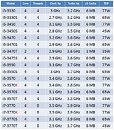Monday, November 28th 2011

Intel Ivy Bridge Desktop Processor Models Tabled
Russian website Overclockers.ru claims to have a complete picture of what Intel's upcoming 22 nm Core "Ivy Bridge" desktop (2012 Core Processor Family) looks like. The site compiled model names, extensions, clock speeds, Turbo Boost speeds, L3 cache sizes, and TDP ratings of as many as 18 models, most of which are quad-core.
The table reflects that most clock speeds are similar to today's Sandy Bridge LGA1155 processor models, some have Turbo Boost speeds as high as 3.90 GHz. Since Ivy Bridge silicon is an optical shrink of Sandy Bridge LGA1155, from 32 nm to 22 nm, and since Intel is using a more energy-efficient transistor design, there are significant improvements in TDP ratings.
Source:
Overclockers.ru
The table reflects that most clock speeds are similar to today's Sandy Bridge LGA1155 processor models, some have Turbo Boost speeds as high as 3.90 GHz. Since Ivy Bridge silicon is an optical shrink of Sandy Bridge LGA1155, from 32 nm to 22 nm, and since Intel is using a more energy-efficient transistor design, there are significant improvements in TDP ratings.

57 Comments on Intel Ivy Bridge Desktop Processor Models Tabled
Hmm I expected a bigger drop in power than this from the 22nm Tri-gate process :/Scratch that - there's more l3 cache. InterestingI'll have the 8 thread i7-3770K to go, along with a side order of fries and ketchup. ;)Yes, that's true. When you consider the lack of competition from AMD and the fact that even a low end CPU can run most things including 3D games very well, it's not surprising.
i5-3450S should be 65W
(I'm only pointing this out because it got me confused...)
There might also be a i5-3450T at 45W... who knows.
An Ivy bridge e would be more palletable than sbe though
1) Only a single dual-core option? Dual core CPUs is where Intel makes most of their profits. Its not like most consumers really need 4 cores.
2) Similarly, why so many more quad core options than with SB?
3) Fill out the rest of the table with what it *should* have suddenly you're talking about way too many chips
earlier dual-cores were highend single cores were mainstream ... then dualcores were mainstream and quad-cores were highend ... catch the pattern ... :toast:
Taking the data at face value, does this mean that wattage is scaling non-linearly with core speed? Kind of hints that the K models will overclock like crazy. I hope so!
At least that is how I see it, I could be wrong though.